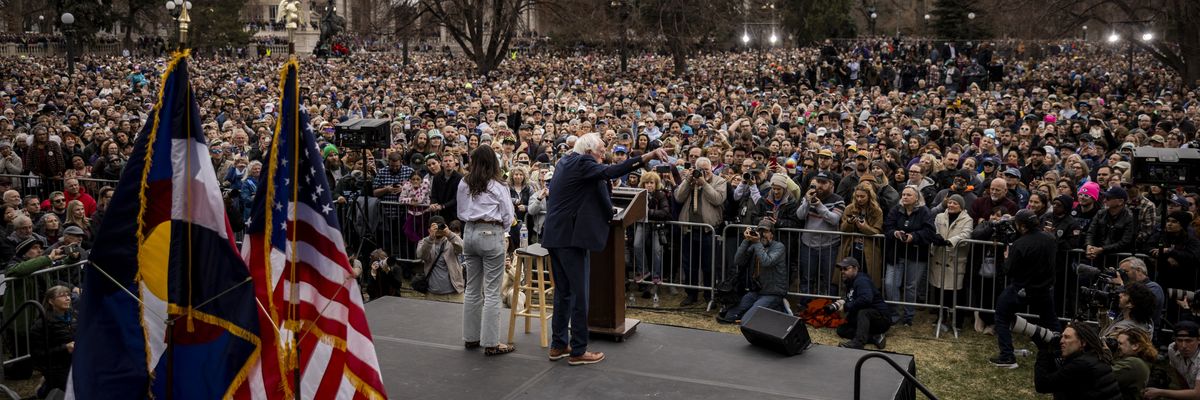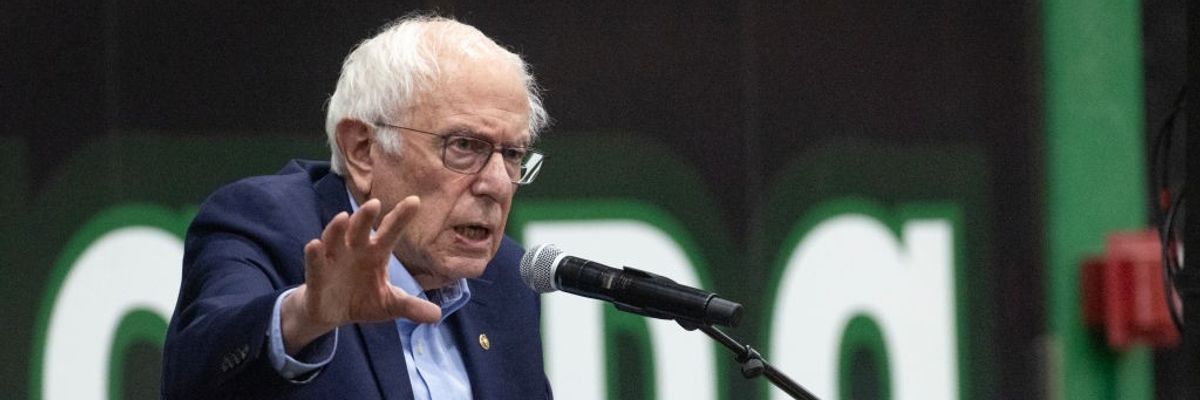Shaking the Cherries Down
As an antifascist movement awakens, our job is to build organization


It’s spring, a season of hope, and the prairie grass is dry, waiting for sparks. And we face a clear challenge from the Trump fascist clique. People are suffering. Some are being “disappeared.” We are called to fight.
Antifascist movements don’t arise out of nowhere. The clique now in the White House sets them in motion by inflicting one outrage after another against people’s liberties, lives, and livelihoods.
In the past week alone, some 550 grassroots protests emerged in every state—with dozens, naturally, in D.C. itself, the seat of federal power. That power is now split into three: those defending the fascists, those enabling it by conciliation or silence, and those taking stands against it in various ways. We have to learn how to use contradictions among those on top, while healing contradictions among the people at the base.
I am thrilled by the tens of thousands turning out in the heartland for Bernie and AOC. A large coalition of the progressive organizers behind the upsurge has already formed. It’s calling on all of us to turn out on Saturday, April 5, 2025. There will be a very large mobilization in D.C. But if you can’t make it there, substantial local mobilizations also will take place in nearly every city and college town in the country.
We have dozens of reasons to join them and even more demands to be raised. The tip of our spear must aim at the ICE/DHS secret raid against immigrants, documented or not, who have spoken out against the genocide being inflicted on Gaza. The thugs start here because they consider it low-hanging fruit, our weak point, believing that these voices are a despised minority within another unpopular minority of a wider peace and justice movement. We demand a foreign policy in tune with the UN Charter and its Principle of Peaceful Coexistence.
We must do a deeper exposure of Team Trump and prove them and their policy of division wrong. The core value in all our diverse narratives of who we are and what we want is solidarity. An injury to one of us is an injury to all of us. We don’t have to agree with everything any of those targeted might say. But we must stand with them on the right to speak, the right to equality before the law, and the right to due process. Most of all, we want their voices in our campaigns and organizations.
Our 14th Amendment gives these “due process” rights to all persons in our country, whether they are citizens or not. If you think otherwise, you are abandoning what it means to be an American. You are abandoning the legacy of our “Second Revolution,” of the 500,000 or more who perished, Black, white, and otherwise, those who “gave the last full measure of devotion.” Moreover, “It is for us the living, rather, to be dedicated here to the unfinished work which they who fought,” for a nation rooted in an abolition democracy. This is the core value that is never granted to us by our “betters,” and never can be. Why? Because, self-evidently, these core values and natural rights are part of our nature as social beings. Tyrants can deny them or try to restrict them, but they can never take them away.
We demand that today’s anti-American neo-confederates stop all their fascist projects. We aim for their removal from power. We demand that they and any successors respect the rights of immigrants and welcome those fleeing injustice. We demand that they stop their attacks on veterans, whom Trump has always despised, and restore the VA and its hospitals and benefits. We demand they cease their attacks on the Department of Labor and the NLRB. All workers have the right to form unions in every state and to stand up for better wages, working conditions, and the expansion of social justice. We demand the restoration of all DEI measures won in all the civil rights battles of every decade. There is one race, the human race, and we defend the rights of all, regardless of skin color, language, or religious faith. We demand respect and equality for all women, including health care and abortion rights. The attacks on doctors and their female patients must cease and desist in every state. Likewise for all LGBTQ persons. In short, we want consistent democracy for all the exploited and oppressed, all along the line.
Our task in the weeks ahead is to join these movements and “fan the flames of discontent.” But we also must avoid a trap, one this writer observed earlier in the Jesse Jackson campaigns of the 1980s. My organization at that time, the League of Revolutionary Struggle, or LRS, played an important role in shaping Jesse’s Rainbow Coalition. Jackson started with a firm base in Chicago’s Black and Latino communities. But LRS did important work in bringing in Chicanos, Chinese-Americans, Filipinos, and all Pacific Islanders and others. (I worked with a small team taking Jesse to Iowa and Nebraska, bringing in progressive farmers, the “green stripe” in the Rainbow).
We saw ourselves as “building a movement.” But Jesse frequently warned us: “My job is to shake the cherries down from the tree. But I can’t do it all. Your job is to gather up the harvest on the ground.” We found the wisdom in that warning the hard way, soon after the election activities ebbed. All the “build a movement” assertions turned into empty air. We won a few new recruits to the LRS here and there, but not much else, even though a few of us continued with staff positions in Jesse’s Rainbow-Push operation in Chicago.
“My job is to shake the cherries down from the tree. But I can’t do it all. Your job is to gather up the harvest on the ground.” -Jesse Jackson
We fell into the “build the movement” trap. We do not create movements. We can see what actually builds them every day, with the flurry of Oval Office assaults and inflections on us everywhere. Wherever there is oppression, there is resistance.
But it’s also true that movements, like everything else in the universe, move in waves; they flow, and they ebb. At one point of upsurge in the “long 1960s,” we thought it would be ever upward and onward, and when the ebb came, our old set of tactics for flow failed miserably. Think of the Weather Underground as an extreme case in point.
We can help build movement in many ways, such as by fanning the flames. But to avoid the hidden trap, we must also build structured campaigns and new mass organizations within movements. Organizations of all sorts are our most essential weapons, including but not limited to our own socialist organizations. The socialists who think straight matter a great deal. As Uncle Ho once noted, “the harder the core, the broader the front.” We have a far-sighted strategy and tactics. If we deploy them well, everyone in our common front can grow.
But the key important lesson arises as the wave begins to ebb. We have to know when to cast the net out, during the flow, and when to draw the net in, when the crest begins to ebb. We need to keep stronger and larger campaigns, like Rev. Barbor’s “Third Reconstruction” and organizations within it that can survive and thrive either way, so when the next wave comes, we start on higher ground with better and larger organizations. We especially need this when we are in Gramsci’s “war of position,” where we engage in our “long march” winning “strong points” (Lenin) in all of them. Why? Because at some point the crisis deepens, and we face the tasks of winning governing power—a war of movement that can start to “capture the castles,” tactically, at all levels, starting with cities, counties, and states.
At some point, the war of movement will arise everywhere, and a dual power will become a new power. This will create new problems. We would all love to have these new problems on our plates, but we are not there yet. For the moment, we solve the problem of organization-building within movement-building.
Here’s a closing hint for an efficient way to do all this: when you go to a protest event or action, take a clipboard, pens, and calling cards with you. Then ask questions of people you don’t know, outside your comfort zone, listen to them, and ask more. Learn to persuade by sharing common passions of weal and woe. Record and report. If you don’t take these tools, you are simply an activist. If you do and you use them well, you are an organizer and a party-builder. Now is the time for us to build.








